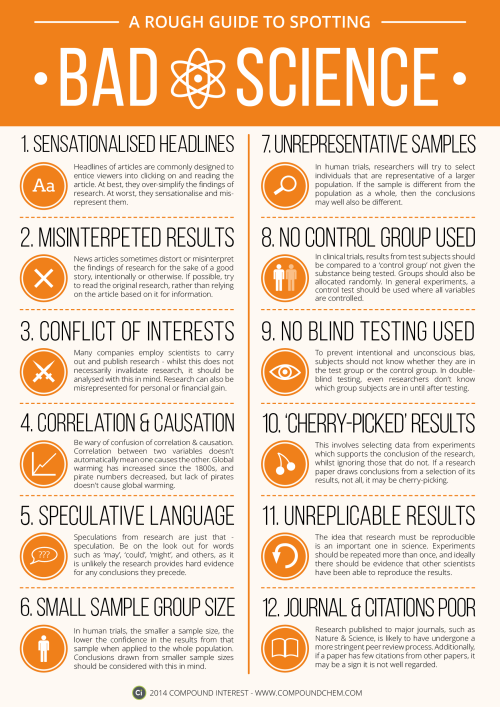Acting Outrageous And Making A Complete Fool Of Yourself While Drunk Has Been Linked To A Genetic Mutation.

Acting outrageous and making a complete fool of yourself while drunk has been linked to a genetic mutation. It blocks the production of one of the body’s serotonin receptors, which can affect mood swings, impulsive behavior, and decision making. So far, the mutation has only been found in Finnish people, but the discovery is helping researchers understand more about the role serotonin plays in your body. Source Source 2
More Posts from Science-is-magical and Others

Version 1 of ‘A Rough Guide to Spotting Bad Science’. Thanks for everyone’s suggestions earlier in the week, attempted to include as many of them as possible!
Download link here: http://wp.me/p4aPLT-ap

Now we know the (proposed) names of the four new elements, here’s an updated graphic with more information on each! High-res image/PDF: http://wp.me/p4aPLT-1Eg

(Image caption: In this illustration, a pair of eyeglasses “resolves” distinct serotonin neuron subtypes (shown as brightly colored cells) on a simple map of a region called the raphe in the mouse brain. By viewing serotonin neurons through multiple “lenses”—such as single-neuron and population-scale global gene expression, developmental lineage and anatomy—researchers have revealed diverse subtypes and principles of subtype organization in the brain. Credit: Mallory Rice)
Time for a New Definition
It used to be enough to call a serotonergic neuron a serotonergic neuron.
These brain cells make the neurotransmitter serotonin, which helps regulate mood, appetite, breathing rate, body temperature and more.
Recently, however, scientists have begun to learn that these neurons differ from one another—and that the differences likely matter in dysfunction and disease.
Last year, a team led by Harvard Medical School genetics professor Susan Dymecki defined a subgroup of serotonergic neurons in mice by showing that those cells specifically, among all serotonergic neurons, were responsible for increasing the breathing rate when too much carbon dioxide builds up in the body.
Now, Dymecki and colleagues have taken a first stab at systematically characterizing serotonergic neurons at the molecular level and defining a full set of subtypes, again in mice.
The researchers report in Neuron that serotonergic neurons come in at least six major molecular subtypes defined by distinct expression patterns of hundreds of genes. In many cases, the subtypes modulate different behaviors in the body.
By conducting a cross-disciplinary series of experiments, the researchers found that the subtypes also vary in their developmental lineage, anatomical distribution, combinations of receptors on the cell surface and electrical firing properties.
“This work reveals how diverse serotonin neurons are at the molecular level, which may help to explain how, collectively, they are able to perform so many distinct functions,” said Benjamin Okaty, a postdoctoral researcher in the Dymecki lab and co-first author of the paper.
“To have the list of molecular players that make each of these subtypes different from one another gives us an important handle on learning more about what that cell type does and how we can manipulate only that subtype,” said Dymecki. “It holds enormous therapeutic potential.”
“This is an ancient neurotransmitter system that’s implicated in many different diseases, and it’s starting to be cracked open,” said Morgan Freret, a graduate student in the Dymecki lab and co-first author of the paper. “We can now ask questions in a more systematic way about which serotonergic cells and molecules are important in, for example, pain, sleep apnea or anxiety.”
Crucially, the team also showed that a serotonergic neuron’s gene expression and function depend not only on its location in the adult brain stem, but also on its cellular ancestor in the developing brain.
“Earlier work had shown that you could explore the relationship between a mature neuronal system and the different developmental lineages that gave rise to it, but we had no idea whether it was meaningful,” said Dymecki. “We show that the molecular phenotypes of these neurons track quite tightly to their developmental origin, with anatomy making some interesting contributions as well.”
While the work was done in mice, Dymecki is optimistic that it will be replicated in humans because the serotonergic neuronal system is in a highly conserved region of the brain, meaning it tends to remain consistent across vertebrate species.
Because of this, researchers can look for the same molecular signatures in human tissue and begin to tease apart whether particular subtypes of serotonergic neurons are involved in conditions such as sudden infant death syndrome (SIDS) or autism.
Such research could ultimately reveal previously unknown contributions of the serotonergic neuronal system to disease, inform the development of biomarkers or lead to more targeted therapies.
The team’s findings could also inform stem cell research. “Which subtype of serotonergic neuron are we getting when we use current stem cell protocols?” asked Dymecki. “Can we drive the development of different subtypes? Can we watch how gene expression patterns change over time during development for each subtype?”
Finally, the study provides an example of a highly integrative approach to understanding brain function at multiple scales, “linking genes and gene networks to the properties of single neurons and populations of neuron subtypes, all the way up to the level of animal behaviors,” said Okaty. “I think it’s a useful template going forward. Imagine what we’d learn by applying this approach to all the neurotransmitter systems in the brain.”
-
 bananabatman-blog liked this · 3 years ago
bananabatman-blog liked this · 3 years ago -
 voidpoultry liked this · 4 years ago
voidpoultry liked this · 4 years ago -
 luminietos liked this · 5 years ago
luminietos liked this · 5 years ago -
 jewishdumbass liked this · 5 years ago
jewishdumbass liked this · 5 years ago -
 comic-cosmic-lover liked this · 6 years ago
comic-cosmic-lover liked this · 6 years ago -
 elfo8792 liked this · 6 years ago
elfo8792 liked this · 6 years ago -
 suck-mein-pokeballs liked this · 7 years ago
suck-mein-pokeballs liked this · 7 years ago -
 badtz liked this · 7 years ago
badtz liked this · 7 years ago -
 nanaeldaria liked this · 7 years ago
nanaeldaria liked this · 7 years ago -
 the-ghost-of-jason-todd liked this · 7 years ago
the-ghost-of-jason-todd liked this · 7 years ago -
 demoncatlady liked this · 7 years ago
demoncatlady liked this · 7 years ago -
 vampirepolitician liked this · 7 years ago
vampirepolitician liked this · 7 years ago -
 varjotin reblogged this · 7 years ago
varjotin reblogged this · 7 years ago -
 varjotin liked this · 7 years ago
varjotin liked this · 7 years ago -
 margiepartie liked this · 7 years ago
margiepartie liked this · 7 years ago -
 thevoid55 liked this · 7 years ago
thevoid55 liked this · 7 years ago -
 anbuccbrow-blog liked this · 7 years ago
anbuccbrow-blog liked this · 7 years ago -
 117septimus liked this · 7 years ago
117septimus liked this · 7 years ago -
 cococapes liked this · 7 years ago
cococapes liked this · 7 years ago -
 destiel110000 liked this · 7 years ago
destiel110000 liked this · 7 years ago -
 kisama666 liked this · 8 years ago
kisama666 liked this · 8 years ago -
 gaarbaageegremlin liked this · 8 years ago
gaarbaageegremlin liked this · 8 years ago -
 hippiebydayrickymartin reblogged this · 8 years ago
hippiebydayrickymartin reblogged this · 8 years ago -
 anitavanitas reblogged this · 8 years ago
anitavanitas reblogged this · 8 years ago -
 thefoodyouate liked this · 8 years ago
thefoodyouate liked this · 8 years ago -
 rottakuningas liked this · 8 years ago
rottakuningas liked this · 8 years ago -
 science-is-magical reblogged this · 8 years ago
science-is-magical reblogged this · 8 years ago -
 alecsiratze liked this · 8 years ago
alecsiratze liked this · 8 years ago -
 marvelisgaynow reblogged this · 8 years ago
marvelisgaynow reblogged this · 8 years ago -
 muistikatkos liked this · 8 years ago
muistikatkos liked this · 8 years ago -
 lipuluu reblogged this · 8 years ago
lipuluu reblogged this · 8 years ago -
 ihmemangusti reblogged this · 8 years ago
ihmemangusti reblogged this · 8 years ago -
 kitekraschu reblogged this · 8 years ago
kitekraschu reblogged this · 8 years ago -
 angelcommunist liked this · 8 years ago
angelcommunist liked this · 8 years ago -
 hyberspede liked this · 8 years ago
hyberspede liked this · 8 years ago -
 the-foxy-fam-and-friends liked this · 8 years ago
the-foxy-fam-and-friends liked this · 8 years ago -
 violaceaes reblogged this · 8 years ago
violaceaes reblogged this · 8 years ago -
 bigvssfairy reblogged this · 8 years ago
bigvssfairy reblogged this · 8 years ago -
 gottaloveitreally liked this · 8 years ago
gottaloveitreally liked this · 8 years ago -
 maijaat reblogged this · 8 years ago
maijaat reblogged this · 8 years ago -
 diipadaapaduu-blog reblogged this · 8 years ago
diipadaapaduu-blog reblogged this · 8 years ago -
 finirr reblogged this · 8 years ago
finirr reblogged this · 8 years ago -
 nojavittu-blog reblogged this · 8 years ago
nojavittu-blog reblogged this · 8 years ago -
 espritaberrance liked this · 8 years ago
espritaberrance liked this · 8 years ago













